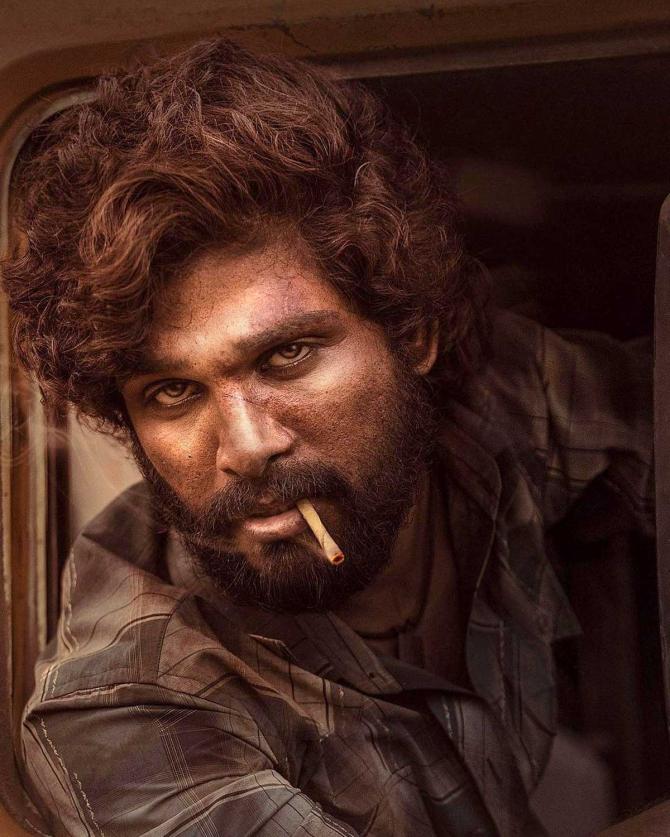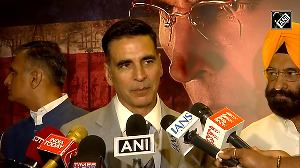'This is the best time to do a pan-Indian film.'

How did we get here?
Basil Joseph's Minnal Murali (Malayalam) is a sweet, unusual, superhero film.
On Christmas eve, Jaison, a tailor, and Shibu, an outcast in a village in Kerala, are struck by lightning.
They develop superhero powers causing havoc in their lives and those of the villagers.
Within a few days of its release on Netflix in December 2021, Minnal Murali hit the top 10 charts in 30 countries including India, Argentina, Brazil, Nigeria, Malaysia, Sri Lanka and Singapore.
"It truly broke out pan-India and globally," says Pratiksha Rao, director, original films and licensing, Netflix India.
What Minnal Murali did online, the Allu Arjun-starrer Pushpa (Telugu) has done offline.
According to trade portal Box Office Biz, Pushpa, released in December 2021, grossed over Rs 360 crore (Rs 3.6 billion) in 40 days and counting.
Roughly half this money came from the Telugu-speaking regions.
Of the rest over Rs 100 crore (Rs 1 billion) came from the Hindi belt.
Pushpa is, arguably, one of the biggest pan-India hits after Baahubali (Telugu/Hindi).
"Allu Arjun was clear that Pushpa would travel all India," says Ajit Thakur, CEO of the Telugu movie app, Aha.

Waiting to make that journey is Baahubali Director S S Rajamouli's next film, RRR.
The story of two fictional freedom fighters starring NT Rama Rao junior, Ram Charan, Alia Bhatt and Ajay Devgn will be released theatrically in five languages this month.
Sixty days after its release, Netflix will stream RRR in Hindi, and ZEE5 in Telugu, Tamil, Malayalam and Kannada.
Disney-Star's TV channels will broadcast it in the four South Indian languages, while ZEE TV will do that in Hindi.
"We wanted the film to reach everywhere. Not a single person can say that I did not see the film," says Jayantilal Gada, founder and chairman of PEN Studios.
It owns all, except South Indian theatrical rights, for the film.
KGF 2 (Kannada) and Radhe Shyam (Telugu, Hindi) are expected to follow soon.
"This is the best time to do a pan-Indian film," says Ajit Andhare, Chief Operating Officer, Viacom18 Studios. The business incentive is simple enough.
"The more we are able to reach out, the better it is for the business," says Apoorva Mehta, CEO, Dharma Productions.
A pan-Indian film means big bucks -- theatrical revenues upwards of Rs 150 crore-Rs 200 crore (Rs 1.5 billion-Rs 2 billion) plus OTT and TV.
"Baahubali netted about Rs 510 crore [Rs 5.1 billion] (theatrically) in North India alone, RRR might break that record," says Gada.
Not surprisingly every major production house is looking for the pan-Indian film.
"In the last one year, there have been 10-12 bilingual films with South and Hindi stars. For every month of this year a film from the South will get a national release," says Shailesh Kapoor, CEO, Ormax Media.
"India is driving towards the next chapter of entertainment," reckons Mehta.

The single biggest shift in the business of cinema in recent years -- the rise of the pan-Indian film -- is creating one market for its many languages.
"Forever the Hindi film has tried to be the pan-Indian film and several South Indian films tried the same with Kamal Haasan and Ram Charan. But the Hindi and South Indian films never made it over to the other markets," says Andhare.
In the eighties and nineties, anyone wanting to watch a good Malayalam, Tamil or Marathi film had to watch a tape or DVD, in the original, without subtitles or dubbing.
By the turn of the millennium this changed with Hindi movie channels doing roaring business with dubbed versions of Tamil and Telugu films.
It created a familiarity with the aesthetics and faces of other cinemas.
"These films (Pushpa or Minnal Murali) have walked on the bridges built by Hindi broadcasters," says Andhare.
When OTT took off in 2016, the possibilities for crossing over exploded.
"OTT eased access and discovery of films from different languages," says Rao.
More than half the viewership of Indian language films on Amazon Prime Video comes from outside the home state, says Gaurav Gandhi, country head, Amazon Prime Video, India.
Add up roughly a decade of dubbed films on television and five years of OTT, and you have an audience that is absolutely open to and welcoming of the pan-Indian film.
That is the first of the two factors behind the rise of the pan-Indian film.
The second, and the one that explains why Hindi hasn't crossed over as much, is the multiplex skew.
For decades, film-makers across India have catered to 1,000-seater single screens that demanded the massy, big spectacle films.
These filled up the theatre and ensured profits at very low ticket prices.
However, when corporatisation took off in the early part of the millennium, multiplex screens began rising.
It allowed for experimentation, variety and higher prices, changing the nature of the game.
As a result, Hindi became a multiplex-oriented, more realistic cinema.
The massy, entertainer, a la Sooryavanshi, became a rarity.

On the other hand, the Southern markets are still largely dependent on single screens and so have their finger on the pulse of that audience.
"There are great storytellers in Hindi and Malayalam, but they don't make pan-Indian films. You need to make a film that unites the man in the rickshaw and the one in an Audi. Andhadhun is a good film, but it will travel only as a remake," says Thakur.
This is true for Bengali, Marathi or Assamese, home to some outstanding films.
It is, however, a rare one -- like Sairat (Marathi) -- that breaks through.
Many of them -- Drishyam 2, Joji -- work very well on OTT. "Malayalam cinema is largely concept-driven, more nuanced. It is tailor-made for OTT," says Kapoor.
On the other hand, "Pushpa is about the Hindi audience telling you it needs a masala film," says Andhare.
Since it is spoken and watched by roughly 8-10 times more people than any other language, Hindi is the biggest chunk of the Rs 19,100 crore [Rs 191 billion] (pre-pandemic) Indian film business.
However, its inability to fill the gap for the mass film has meant that Telugu cinema has zoomed ahead at the box office in 2020 and 2021, according to The Ormax Box Office Report.
As other cinemas play catch-up, the balance will keep shifting.
But the pan-Indian film is the new business reality of Indian cinema.
Feature Presentation: Aslam Hunani/Rediff.com













 © 2025
© 2025